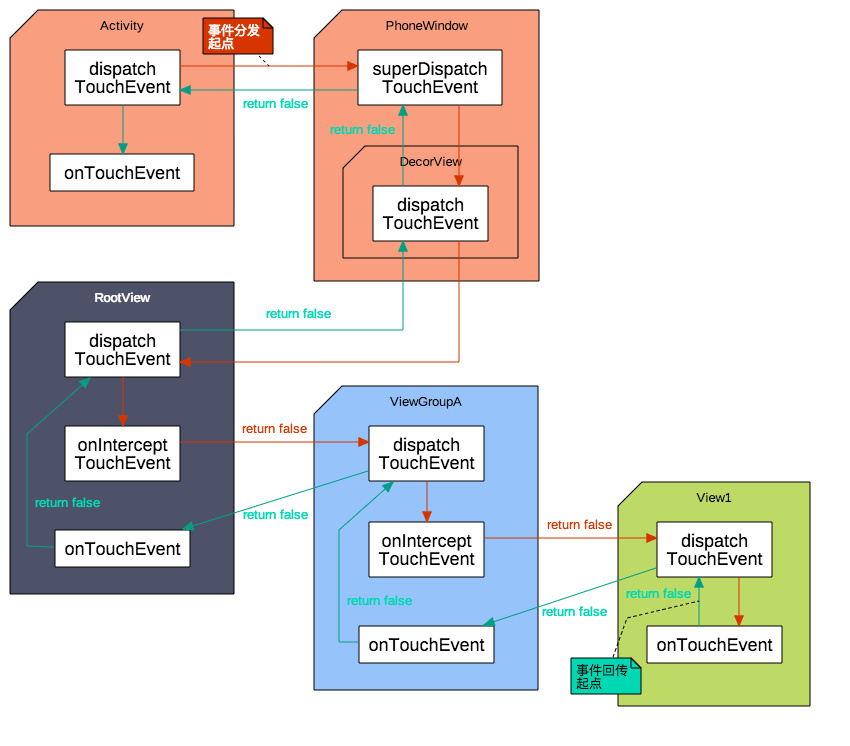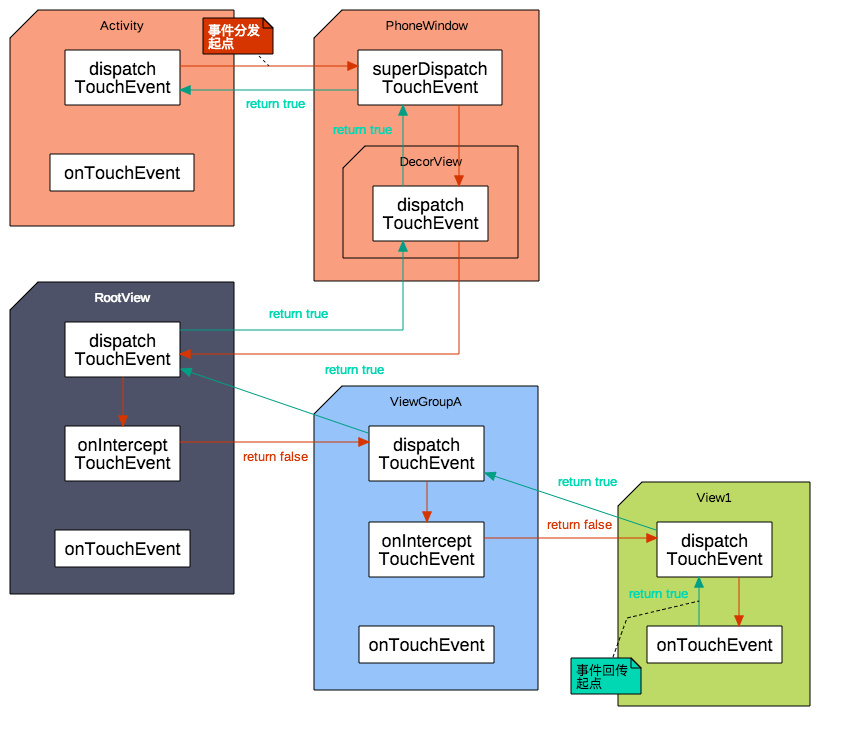Android事件分发与责任链模式
一、责任链模式
责任链模式是一种行为模式,为请求创建一个接收者的对象链.这样就避免,一个请求链接多个接收者的情况.进行外部解耦.类似于单向链表结构。
优点:
1. 降低耦合度。它将请求的发送者和接收者解耦。
2. 简化了对象。使得对象不需要知道链的结构。
3. 增强给对象指派职责的灵活性。通过改变链内的成员或者调动它们的次 序,允许动态地新增或者删除责任。
4. 增加新的请求处理类很方便。
缺点:
1. 不能保证请求一定被接收。
2. 系统性能将受到一定影响,而且在进行代码调试时不太方便,可能会造成循环调用。
3. 可能不容易观察运行时的特征,有碍于除错。
在Android事件分发机制是责任链模式最典型的应用:
dispatchTouchEvent的,就是责任链中的将事件交给下一级处理的.
onInterceptTouchEvent ,就是责任链中,处理自己处理事务的方法.
onTouchEvent 是责任链中 事件上报的事件链。
下面我们来通过Android事件分发机制来感悟一下责任链模式在Android中的应用。
二、Android 事件分发传递机制
1. View事件传递分发层级结构
a). 事件收集之后最先传递给 Activity, 然后依次向下传递,大致如下:
Activity -> PhoneWindow -> DecorView -> ViewGroup -> ... -> View
这样的事件分发机制逻辑非常清晰,可是,你是否注意到一个问题?如果最后分发到View,如果这个View也没有处理事件怎么办,就这样让事件浪费掉?当然不会啦。
b). 如果没有任何View消费掉事件,那么这个事件会按照反方向回传,最终传回给Activity,如果最后 Activity 也没有处理,本次事件才会被抛弃:
Activity <- PhoneWindow <- DecorView <- ViewGroup <- ... <- View
可以看到,这是一个非常经典的责任链模式,如果我能处理就拦截下来自己干,如果自己不能处理或者不确定就交给责任链中下一个对象。 这种设计是非常精巧的,上层View既可以直接拦截该事件,自己处理,也可以先询问(分发给)子View,如果子View需要就交给子View处理,如果子View不需要还能继续交给上层View处理。既保证了事件的有序性,又非常的灵活。
View点击事件分发有三个关键流程方法:
1.dispatchTouchEvent:事件下发 --- View和ViewGroup都有的方法
2.onInterceptTouchEvent:拦截下发的事件,并交给自己OnTouchEvent处理处理 ---ViewGroup才有的方法
3.onTouchEvent:事件上报 --- View和ViewGroup都有的方法
以下是不同层级对事件的分发、拦截和消费的功能表:

可以看到 Activity 和 View 都是没有事件拦截的:
a). Activity 作为原始的事件分发者,如果 Activity 拦截了事件会导致整个屏幕都无法响应事件,这肯定不是我们想要的效果。
b). View最为事件传递的最末端,要么消费掉事件,要么不处理进行回传,根本没必要进行事件拦截。
下图是点击View,事件传递但是都没有被处理,生成的一个完整的事件分发流程图:

如果事件被View处理了,那么事件分发流程图应该如下:

如果事件被ViewGroup拦截处理了, 那么事件分发流程图应该如下:

从上面的流程,我们可以概括Android的事件分发机制为:责任链模式,事件层层传递,直到被消费。
三、Q&A
上面我们讲解了一下Android的事件分发机制,可能很多人会有疑惑,下面我们针对部分疑惑进行分析和说明:
1. 为什么 View 会有 dispatchTouchEvent ?
答:我们知道 View 可以注册很多事件监听器,例如:单击事件(onClick)、长按事件(onLongClick)、触摸事件(onTouch),并且View自身也有 onTouchEvent 方法,那么问题来了,这么多与事件相关的方法应该由谁管理?毋庸置疑就是 dispatchTouchEvent,所以 View 也会有事件分发。
View的dispatchTouchEvent源码:
/**
* Pass the touch screen motion event down to the target view, or this
* view if it is the target.
*
* @param event The motion event to be dispatched.
* @return True if the event was handled by the view, false otherwise.
*/
public boolean dispatchTouchEvent(MotionEvent event) {
// If the event should be handled by accessibility focus first.
if (event.isTargetAccessibilityFocus()) {
// We don't have focus or no virtual descendant has it, do not handle the event.
if (!isAccessibilityFocusedViewOrHost()) {
return false;
}
// We have focus and got the event, then use normal event dispatch.
event.setTargetAccessibilityFocus(false);
} boolean result = false; if (mInputEventConsistencyVerifier != null) {
mInputEventConsistencyVerifier.onTouchEvent(event, 0);
} final int actionMasked = event.getActionMasked();
if (actionMasked == MotionEvent.ACTION_DOWN) {
// Defensive cleanup for new gesture
stopNestedScroll();
} if (onFilterTouchEventForSecurity(event)) {
if ((mViewFlags & ENABLED_MASK) == ENABLED && handleScrollBarDragging(event)) {
result = true;
}
//noinspection SimplifiableIfStatement
ListenerInfo li = mListenerInfo;
if (li != null && li.mOnTouchListener != null
&& (mViewFlags & ENABLED_MASK) == ENABLED
&& li.mOnTouchListener.onTouch(this, event)) {
result = true;
} if (!result && onTouchEvent(event)) {
result = true;
}
} if (!result && mInputEventConsistencyVerifier != null) {
mInputEventConsistencyVerifier.onUnhandledEvent(event, 0);
} // Clean up after nested scrolls if this is the end of a gesture;
// also cancel it if we tried an ACTION_DOWN but we didn't want the rest
// of the gesture.
if (actionMasked == MotionEvent.ACTION_UP ||
actionMasked == MotionEvent.ACTION_CANCEL ||
(actionMasked == MotionEvent.ACTION_DOWN && !result)) {
stopNestedScroll();
} return result;
}
2. View事件分发时各个方法调用顺序是怎样的?
a). 单击事件(onClickListener) 需要两个两个事件(ACTION_DOWN 和 ACTION_UP )才能触发,如果先分配给onClick判断,等它判断完再交由其他相应时间显然是不合理的,会造成 View 无法响应其他事件,应该最后调用。(所以此调用顺序最后)
b). 长按事件(onLongClickListener) 同理,也是需要长时间等待才能出结果,肯定不能排到前面,但因为不需要ACTION_UP,应该排在 onClick 前面。(onLongClickListener > onClickListener)
c). 触摸事件(onTouchListener) 如果用户注册了触摸事件,说明用户要自己处理触摸事件了,这个应该排在最前面。(最前)
d). View自身处理(onTouchEvent) 提供了一种默认的处理方式,如果用户已经处理好了,也就不需要了,所以应该排在 onClickListener 后面。(onTouchListener > onClickListener)
所以事件的调度顺序应该是 onTouchListener > onTouchEvent > onLongClickListener > onClickListener。
3. ViewGroup 的事件分发流程又是如何的呢?
在默认的情况下 ViewGroup 事件分发流程是这样的。
a). 判断自身是否需要(询问 onInterceptTouchEvent 是否拦截),如果需要,调用自己的 onTouchEvent。
b). 自身不需要或者不确定,则询问 ChildView ,一般来说是调用手指触摸位置的 ChildView。
c). 如果子 ChildView 不需要则调用自身的 onTouchEvent。
ViewGroup的dispatchTouchEvent源码:
@Override
public boolean dispatchTouchEvent(MotionEvent ev) {
if (mInputEventConsistencyVerifier != null) {
mInputEventConsistencyVerifier.onTouchEvent(ev, 1);
} // If the event targets the accessibility focused view and this is it, start
// normal event dispatch. Maybe a descendant is what will handle the click.
if (ev.isTargetAccessibilityFocus() && isAccessibilityFocusedViewOrHost()) {
ev.setTargetAccessibilityFocus(false);
} boolean handled = false;
if (onFilterTouchEventForSecurity(ev)) {
final int action = ev.getAction();
final int actionMasked = action & MotionEvent.ACTION_MASK; // Handle an initial down.
if (actionMasked == MotionEvent.ACTION_DOWN) {
// Throw away all previous state when starting a new touch gesture.
// The framework may have dropped the up or cancel event for the previous gesture
// due to an app switch, ANR, or some other state change.
cancelAndClearTouchTargets(ev);
resetTouchState();
} // Check for interception.
final boolean intercepted;
if (actionMasked == MotionEvent.ACTION_DOWN
|| mFirstTouchTarget != null) {
final boolean disallowIntercept = (mGroupFlags & FLAG_DISALLOW_INTERCEPT) != 0;
if (!disallowIntercept) {
intercepted = onInterceptTouchEvent(ev);
ev.setAction(action); // restore action in case it was changed
} else {
intercepted = false;
}
} else {
// There are no touch targets and this action is not an initial down
// so this view group continues to intercept touches.
intercepted = true;
} // If intercepted, start normal event dispatch. Also if there is already
// a view that is handling the gesture, do normal event dispatch.
if (intercepted || mFirstTouchTarget != null) {
ev.setTargetAccessibilityFocus(false);
} // Check for cancelation.
final boolean canceled = resetCancelNextUpFlag(this)
|| actionMasked == MotionEvent.ACTION_CANCEL; // Update list of touch targets for pointer down, if needed.
final boolean split = (mGroupFlags & FLAG_SPLIT_MOTION_EVENTS) != 0;
TouchTarget newTouchTarget = null;
boolean alreadyDispatchedToNewTouchTarget = false;
if (!canceled && !intercepted) { // If the event is targeting accessibility focus we give it to the
// view that has accessibility focus and if it does not handle it
// we clear the flag and dispatch the event to all children as usual.
// We are looking up the accessibility focused host to avoid keeping
// state since these events are very rare.
View childWithAccessibilityFocus = ev.isTargetAccessibilityFocus()
? findChildWithAccessibilityFocus() : null; if (actionMasked == MotionEvent.ACTION_DOWN
|| (split && actionMasked == MotionEvent.ACTION_POINTER_DOWN)
|| actionMasked == MotionEvent.ACTION_HOVER_MOVE) {
final int actionIndex = ev.getActionIndex(); // always 0 for down
final int idBitsToAssign = split ? 1 << ev.getPointerId(actionIndex)
: TouchTarget.ALL_POINTER_IDS; // Clean up earlier touch targets for this pointer id in case they
// have become out of sync.
removePointersFromTouchTargets(idBitsToAssign); final int childrenCount = mChildrenCount;
if (newTouchTarget == null && childrenCount != 0) {
final float x = ev.getX(actionIndex);
final float y = ev.getY(actionIndex);
// Find a child that can receive the event.
// Scan children from front to back.
final ArrayList<View> preorderedList = buildTouchDispatchChildList();
final boolean customOrder = preorderedList == null
&& isChildrenDrawingOrderEnabled();
final View[] children = mChildren;
for (int i = childrenCount - 1; i >= 0; i--) {
final int childIndex = getAndVerifyPreorderedIndex(
childrenCount, i, customOrder);
final View child = getAndVerifyPreorderedView(
preorderedList, children, childIndex); // If there is a view that has accessibility focus we want it
// to get the event first and if not handled we will perform a
// normal dispatch. We may do a double iteration but this is
// safer given the timeframe.
if (childWithAccessibilityFocus != null) {
if (childWithAccessibilityFocus != child) {
continue;
}
childWithAccessibilityFocus = null;
i = childrenCount - 1;
} if (!canViewReceivePointerEvents(child)
|| !isTransformedTouchPointInView(x, y, child, null)) {
ev.setTargetAccessibilityFocus(false);
continue;
} newTouchTarget = getTouchTarget(child);
if (newTouchTarget != null) {
// Child is already receiving touch within its bounds.
// Give it the new pointer in addition to the ones it is handling.
newTouchTarget.pointerIdBits |= idBitsToAssign;
break;
} resetCancelNextUpFlag(child);
if (dispatchTransformedTouchEvent(ev, false, child, idBitsToAssign)) {
// Child wants to receive touch within its bounds.
mLastTouchDownTime = ev.getDownTime();
if (preorderedList != null) {
// childIndex points into presorted list, find original index
for (int j = 0; j < childrenCount; j++) {
if (children[childIndex] == mChildren[j]) {
mLastTouchDownIndex = j;
break;
}
}
} else {
mLastTouchDownIndex = childIndex;
}
mLastTouchDownX = ev.getX();
mLastTouchDownY = ev.getY();
newTouchTarget = addTouchTarget(child, idBitsToAssign);
alreadyDispatchedToNewTouchTarget = true;
break;
} // The accessibility focus didn't handle the event, so clear
// the flag and do a normal dispatch to all children.
ev.setTargetAccessibilityFocus(false);
}
if (preorderedList != null) preorderedList.clear();
} if (newTouchTarget == null && mFirstTouchTarget != null) {
// Did not find a child to receive the event.
// Assign the pointer to the least recently added target.
newTouchTarget = mFirstTouchTarget;
while (newTouchTarget.next != null) {
newTouchTarget = newTouchTarget.next;
}
newTouchTarget.pointerIdBits |= idBitsToAssign;
}
}
} // Dispatch to touch targets.
if (mFirstTouchTarget == null) {
// No touch targets so treat this as an ordinary view.
handled = dispatchTransformedTouchEvent(ev, canceled, null,
TouchTarget.ALL_POINTER_IDS);
} else {
// Dispatch to touch targets, excluding the new touch target if we already
// dispatched to it. Cancel touch targets if necessary.
TouchTarget predecessor = null;
TouchTarget target = mFirstTouchTarget;
while (target != null) {
final TouchTarget next = target.next;
if (alreadyDispatchedToNewTouchTarget && target == newTouchTarget) {
handled = true;
} else {
final boolean cancelChild = resetCancelNextUpFlag(target.child)
|| intercepted;
if (dispatchTransformedTouchEvent(ev, cancelChild,
target.child, target.pointerIdBits)) {
handled = true;
}
if (cancelChild) {
if (predecessor == null) {
mFirstTouchTarget = next;
} else {
predecessor.next = next;
}
target.recycle();
target = next;
continue;
}
}
predecessor = target;
target = next;
}
} // Update list of touch targets for pointer up or cancel, if needed.
if (canceled
|| actionMasked == MotionEvent.ACTION_UP
|| actionMasked == MotionEvent.ACTION_HOVER_MOVE) {
resetTouchState();
} else if (split && actionMasked == MotionEvent.ACTION_POINTER_UP) {
final int actionIndex = ev.getActionIndex();
final int idBitsToRemove = 1 << ev.getPointerId(actionIndex);
removePointersFromTouchTargets(idBitsToRemove);
}
} if (!handled && mInputEventConsistencyVerifier != null) {
mInputEventConsistencyVerifier.onUnhandledEvent(ev, 1);
}
return handled;
}
可能看这么长的代码,我们会比较懵,下面我们用伪代码来表示一下:
public boolean dispatchTouchEvent(MotionEvent ev) {
boolean consume = false;
if (onInterceptTouchEvent(ev)) {
consume = onTouchEvent(ev);
} else {
consume = child.dispatchTouchEvent(ev)
}
return consume;
}
这样我们就能更直白的看懂View事件的传递机制了。
4. ViewGroup将事件分发给ChildView的机制
- ViewGroup分发事件时会遍历 ChildView,如果手指触摸的点在 ChildView 区域内就分发给这个View。当 ChildView 重叠时,一般会分配给显示在最上面的 ChildView。
- ViewGroup判断是否需要拦截,主要是根据onInterruptTouchEvent的返回值进行判断。
- 在Down事件中将touch事件分发给ChildView,如果有ChildView捕获消费了Down事件,就会对mFirstTouchTarget进行赋值。mFirstTouchTarget的作用就是记录消费事件的View。
- 在ViewGroup的dispatchTouchEvent方法中,会根据mFirstTouchTarget 是否为 null,决定是自己处理 touch 事件,还是分发给子 View。
- Down事件是touch事件序列的起点,决定了后续的事件由谁来消费处理。Cancel事件的触发场景为:父View先不拦截,但在MOVE事件中又重新拦截,此时子View会收到一个Cancel事件,
5. ViewGroup 和 ChildView 同时注册了事件监听器(onClick等),哪个会执行?
事件优先给 ChildView,会被 ChildView消费掉,ViewGroup 不会响应。
四、参考资料
Android事件分发与责任链模式的更多相关文章
- 设计模式 -- 责任链模式或者叫职责链模式(Chain of Responsibility(CoR))
什么是链?前后相连,一个连接下一个,其中包括多个节点,其实责任链模式也类似,他是多个对象之间相互关联,下一个对象的操作由上一个对象关联下来,上一个对象有个方法用于指向其他对象.职责链之间的前后关系是可 ...
- 我的Java设计模式-责任链模式
今天来说说程序员小猿和产品就关于需求发生的故事.前不久,小猿收到了产品的需求. 产品经理:小猿,为了迎合大众屌丝用户的口味,我们要放一张图,要露点的. 小猿:......露点?你大爷的,让身为正义与纯 ...
- 《Android源码设计模式》--状态模式--责任链模式--解释器模式--命令模式--观察者模式--备忘录模式--迭代器模式
[状态模式] No1: Wifi设置界面是一个叫做WifiSetting的Fragment实现的 No2: 在不同的状态下对于扫描Wifi这个请求的处理是完全不一样的.在初始状态下扫描请求被直接忽略, ...
- python设计模式之责任链模式
python设计模式之责任链模式 开发一个应用时,多数时候我们都能预先知道哪个方法能处理某个特定请求.然而,情况并非总是如此.例如,想想任意一种广播计算机网络,例如最早的以太网实现.在广播计算机网络中 ...
- Android事件分发机制二:viewGroup与view对事件的处理
前言 很高兴遇见你~ 在上一篇文章 Android事件分发机制一:事件是如何到达activity的? 中,我们讨论了触摸信息从屏幕产生到发送给具体 的view处理的整体流程,这里先来简单回顾一下: 触 ...
- 十一个行为模式之责任链模式(Responsible Chain Pattern)
定义: 将具有相同接口的责任类串行在一起,解耦请求的发送者和处理者.沿着这条链进行请求,直到有对象处理它为止. 结构图: Handler:抽象处理类,定义了所有责任类处理方法的接口,不同的处理方法在子 ...
- 第 17 章 责任链模式【Chain of Responsibility Pattern】
以下内容出自:<<24种设计模式介绍与6大设计原则>> 中国古代对妇女制定了“三从四德”的道德规范,“三从”是指“未嫁从父.既嫁从夫.夫死从子”,也就是说一个女性,在没有结婚的 ...
- iOS设计模式解析(五)责任链模式
责任链模式:使多个对象都有机会处理请求,从而避免发送者和接受者之间发生耦合. 应用场景: 有多个对象可以处理请求,而处理程序只有在运行时才能确定 例如: 英雄联盟中伤害计算,伤害类型分为AP.AD.真 ...
- 详解java设计模式之责任链模式
详见:http://blog.yemou.net/article/query/info/tytfjhfascvhzxcyt175 从击鼓传花谈起 击鼓传花是一种热闹而又紧张的饮酒游戏.在酒宴上宾客依次 ...
随机推荐
- 美食家App开发日记4
研究了卡片式布局中的Recyclerview的用法,但是调试了很长时间,导入包总是有问题,一到手机上运行就会闪退.还是在网上查了很多方法,很不开心我还是解决不了.
- 「 从0到1学习微服务SpringCloud 」11 补充篇 RabbitMq实现延迟消费和延迟重试
Mq的使用中,延迟队列是很多业务都需要用到的,最近我也是刚在项目中用到,就在跟大家讲讲吧. 何为延迟队列? 延迟队列就是进入该队列的消息会被延迟消费的队列.而一般的队列,消息一旦入队了之后就会被消费者 ...
- 用 F# 手写 TypeScript 转 C# 类型绑定生成器
前言 我们经常会遇到这样的事情:有时候我们找到了一个库,但是这个库是用 TypeScript 写的,但是我们想在 C# 调用,于是我们需要设法将原来的 TypeScript 类型声明翻译成 C# 的代 ...
- Python的小括号( )、中括号[ ]和大括号{}分别代表什么?
python语言最常见的括号有三种,分别是:小括号( ).中括号[ ]和大括号也叫做花括号{ },分别用来代表不同的python基本内置数据类型. 1.python中的小括号( ):代表tuple元组 ...
- Kafka -入门学习
kafka 1. 介绍 官网 http://kafka.apache.org/ 介绍 http://kafka.apache.org/intro 2. 快速开始 1. 安装 路径: http://ka ...
- nmap详解之原理与用法
前言 nmap是一款开源免费的网络发现(Network Discovery)和安全审计(Security Auditing)工具.软件名字Nmap是Network Mapper的简称.Nmap最初是由 ...
- 1240: 函数strcmp的设计
#include <string.h>#include <stdio.h>int mycmp(char*s1,char*s2);int main(){ int sum; cha ...
- 《算法九》(A星寻路算法)
A星寻路: 结构:N叉树 直线代价斜线代价:符合勾股定理 代价:每走一步,距离终点所付出的 计算公式:f = g + h + w; f : 当前点到终点的代价 g : 起点到当前点的代价 h : 当前 ...
- 实验12: OSPF
实验9-1:单区域点到点链路的OSPF 实验目的通过本实验可以掌握:(1)在路由器上启动OSPF 路由进程(2)启用参与路由协议的接口,并且通告网络及所在的区域(3)度量值cost 的计算(4)点到点 ...
- javabst1an
(单选题)下列概念中不包括任何实现,与存储空间没有任何关系的是() A)类 B)接口 C)抽象类 D)对象 正确答案为:B解析:接口是一种只含有抽象方法或常量的一种特殊的抽象类,因为接口不包括任何实现 ...
